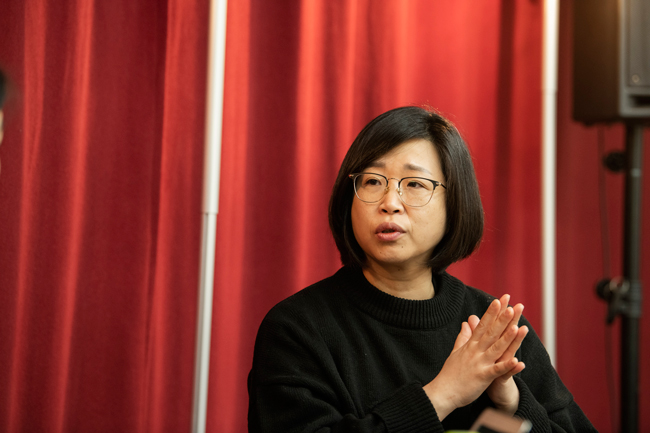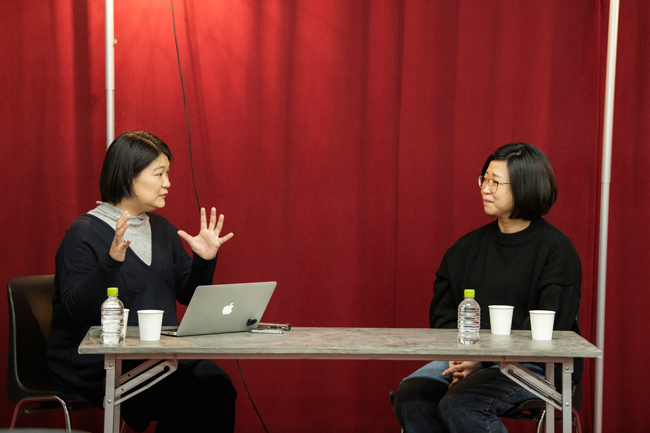
ASIA HUNDREDS is a series of interviews and conference presentations by professionals with whom the Japan Foundation Asia Center works through its many cultural projects.
By sharing the words of key figures in the arts and cultures in both English and Japanese and archiving the "present" moments of Asia, we hope to further generate cultural exchange within and among the regions.
From the position of supporting art to being a producer
OGURA Yukako (hereinafter Ogura): The first time that I met you was when you were residing at Morishita Studio as a visiting fellow*1 for The Saison Foundation. I think that it was in 2011, the year that the programme was established.
*1 A programme run by The Saison Foundation. With the aim of expanding the international network and promoting mutual understanding of contemporary theatre and dance, the programme supports research of the current situation, background and appeal of Japanese contemporary theatre and dance.
Koh Jooyoung (hereinafter Koh): Yes, I was the second visiting fellow. The first was Max-Philip Aschenbrenner.
Ogura: At the time you belonged to the Korea Arts Management Service, didn't you? I believe that your research theme was "Ten-nen (10's) generations" in Japanese performing arts. I have a feeling that you were already knowledgeable about the situation of theatre in Japan, so what interested you to come to Japan for research?
Koh: I do not think that I was particularly knowledgeable about theatre in Japan at the time. The reason why I wanted to do a research about the "Ten-nen (10's) generations" was OZAWA Yasuo, who together with Kim Seong-Hee, organised a project in 2010 to introduce a new generation of Japanese performers at the Nam June Paik Art Center*2. There he introduced work which seemed like but might not be "theatre," performances that would never be called "theatre" in Korea. I found his work to be very interesting and wanted to know more about what was happening in Japan at the time. It had a totally different form and concept to what was being presented in the Korean theatre scene. So I just wanted to look around; that was my biggest motivation.
*2 "Out of Place, Out of Time, Out of Performance". Japanese artists such as contact Gonzo, MANABE Daito, WADA Ei and UMEDA Tetsuya were introduced.
Ogura: In 2011, creations by Neji Pijin and MURAKAWA Takuya were performed as part of the F/T Program at Festival/Tokyo, and they were very much talked about. I think that it was the year that we saw some artists from Asia who took part in this festival being invited to other festivals and expanding their sphere of activities.
Koh: Looking back, I think that I came to Japan at a very good time. contact Gonzo among others had been invited to the performance at Nam June Paik Art Center. It was a performance where people seemed to be colliding and fighting with one another. It was wonderful, but I was shocked when I saw it for the first time since I did not know that such a form of expression even existed.
Ogura: How was the research? Did you yourself change in any way?
Koh: As you can imagine, a lot of interesting things had happened, more than I had anticipated. Before coming to Japan, I had never had the desire to be a creator myself. I had never really come across a work that suited me, so I had never gone so far as to plan something from scratch, but after my research, I was more eager to be involved in experimental theatre that we mentioned just now. As a result of this experience and for other reasons as well, I resigned from my company the following year.
Ogura: Maybe your stay in Japan gave you the opportunity to eventually leave Korea Arts Management Service and shift your direction from supporting art to that of working more closely with artists.
Koh: Even before then, Festival Bo:m*3 had always meant a lot to me, but it did feel a little distant because there was more work from Europe than from Asia. When I learned that there was activity among Japanese artists and that they were creating experimental work, I felt that maybe I could be involved as well.
*3 An Arts Festival held in Korea since 2007. It introduces multi-genre and experimental art expression, crossover "dawon arts" to people both within and outside Korea.

As a key person in the performing arts exchange between Korea and Japan
Ogura: We are interviewing you right now in Japanese, so it is obvious that you are fluent in the language. You have helped many of us in various ways through coordinating, translating and interpreting when Japanese artists go to Korea, and also through curating, translating and interpreting when Korean artists are introduced to Japan. You serve as a bridge between the Japanese and Korean performing arts. I believe that you had studied in Japan to learn the Japanese language before coming here as a visiting fellow for The Saison Foundation.
Koh: It was ten years before coming here as a visiting fellow.
Ogura: Why did you think of studying in Japan?
Koh: It was when I was a university student that we were first allowed to officially import Japanese popular culture.*4 The novels of MURAKAMI Haruki, MURAKAMI Ryu and YOSHIMOTO Banana were the very first to arrive. The movies of KITANO Takeshi and IWAI Shunji also came into Korea through the first wave. I have always loved reading novels, and Murakami Haruki’s novels gave me a big shock. They were written in a completely different style to the novels that I had read which had appealed to me until then. I belong to the last generation of the student movement, so I think I believed that the community was still the most important thing before anything else, but according to his view of the world, it was the individual who made up the community that was the most important. His ideas influenced me. I wanted to be the first to read Murakami Haruki’s latest novel in Japanese and translate it as well, so this is what brought me to Japan.
*4 Before the ban on Japanese popular culture was lifted in 1998, Korea had imposed a restriction on the import of Japanese culture.
Ogura: How did your family and friends react when you told them that you were going to study in Japan?
Koh: Of course there are problems from the past, but regardless, I wanted to react against the fact that many people reacted negatively just on hearing the word, Japan. That was how I became interested in Japan. At least there was no one close to me who objected to me going to Japan. My original plan was to go to Japan for six months and then go to the UK and other countries as well. However, I could not finish reading Murakami Haruki in six months at all, so I ended up staying here for three years.
Ogura: When Mr. NODA Hideki works with a Korean theatre, you are his interpreter, aren't you?
Koh I was not acquainted with Mr. Noda at all. Once when the British production of The Bee by Mr. Noda was invited to Korea, people from the Myeongdong Theater, who we were working with, asked me if I could be the exclusive interpreter to the director. This was because Mr. Noda was going to rehearse with Korean actors for about a month in Seoul*5, and although I was nervous, I accepted. Interpreting for Mr. Noda was a learning experience for me.
I think that he wanted to practise in the same way that he normally did, so he told me not to include the interpreter's point of view. For other people, I usually sort out what is being said and communicate the original words as I understand them, but in the case of Mr. Noda, it was as though I had become an interpreting machine. I would simply speak the words just as I heard them.
*5 Half Gods (2014), an international collaboration project between Tokyo Metropolitan Theatre and Myeongdong Theater: Co-organized by the Japan Foundation
Ogura: So you were always beside him. Mr. Noda shared a lovely story with us. He told us that during rehearsal, when he excused himself to go to the restroom, you followed him.
Koh: Yes, he shared this story in his speech at the opening reception. He thought that this project was going to be a success because I followed him to the restroom. Out of all the interpreters that I have worked with, Mr. Noda has been the most memorable. Through Half Gods, I was fortunate that I was able to win his confidence, and we worked together on the next project as well.
Ogura: Drama Education that Makes Life Easier for High School Students by Ms.ISHII Michiko*6 is one of your recent translations. Could you tell me how you came to translate this book?
*6 Otemon-Gakuin High School teacher (former teacher of Fukushima Prefectural Iwaki Sogo High School)
Koh: For the past two years or so, many of those who have approached me after seeing what I had produced were people who were involved in the field of art education or healing arts. When I asked them why they were interested in my work, they told me, "It seems that what you create is naturally aiming towards that effect." All I wanted to do was to create, but my work also seems to have had an educational or healing effect. I am not an art educator myself, but I understand that maybe what I am aiming at does have an educational element to it.
When I was asked if there was an example of art education that I would like to introduce from Japan, I thought of something that I was interested in, which was education and creation combined. So I contacted Ms. Ishii from Fukushima Prefectural Iwaki Sogo High School, invited her to Korea and talked to her. That is how I came to translate her book.
Ogura: Are there any recent Japanese artists or projects that interest you?
Koh: I am interested in SUGAWARA Naoki and OiBokkeShi. I am looking forward to OiBokkeShi's show at this year's TPAM Fringe. These days my interest is focused on performances where people who normally are not creators stand on stage, where those who have their own stories and histories become protagonists on the stage. sinbunka is another theatre company that is on my mind. I have not seen them yet, but I have heard good things about them.

- Next Page
- Project with SAKAGUCHI Kyohei






